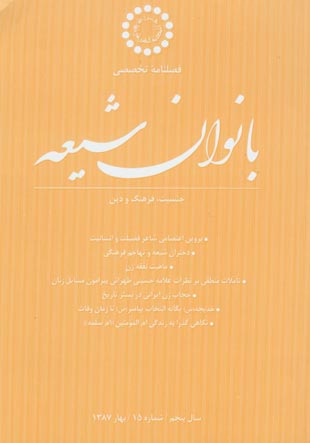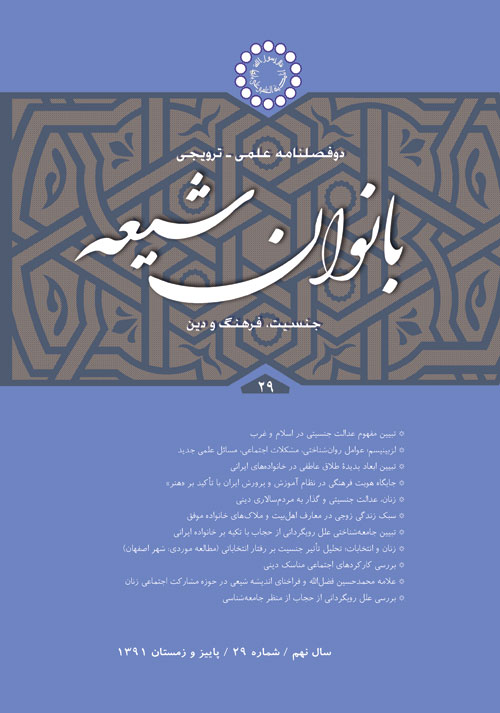فهرست مطالب

نشریه بانوان شیعه
پیاپی 15 (بهار 1387)
- 192 صفحه، بهای روی جلد: 9,500ريال
- تاریخ انتشار: 1387/06/20
- تعداد عناوین: 7
-
صفحه 7زنان با فضیلت و ادیب فراوانی در دامن تشیع ایرانی پرورش یافته اند. یکی از این زنان فرهیخته و ادب دوست پروین اعتصامی است. پروین شاعر فضیلت و تقوا و وارستگی است. از دیدگاه او، جهان جایگاه غفلت، لذت جویی و هدر دادن عمر نیست. تلاش آدمی باید برای عروج از عالم خاکی به عالم بالا و رسیدن به ملکات انسانی باشد. همه چیز در جهان هستی حسابی دقیق دارد و همه کائنات مطیع امر پروردگارند.
در شعر او عشق فردی دیده نمی شود. در عوض، این عشق در همه موجودات هستی جریان پیدا کرده است. در شعر او مناظره میان جانوارن، اشیا و دیگر پدیده ها، همه به نتیجه ای عبرت آموز و اخلاقی و حکیمانه می رسند.
کلیدواژگان: پروین، فضیلت، اخلاق، انسانیت -
صفحه 37مدگرایی و الگوبرداری از فرهنگ بیگانه به عنوان یک موضوع مهم اجتماعی فرهنگی، یکی از معضلات اکثر کشورهای جهان از جمله کشور ما می باشد. سؤال این است که چرا دختران ما به آسانی از الگوهای بیگانه تاثیر می پذیرند و چه عواملی در آن نقش دارند؟ برای بررسی این موضوع بر آن شدیم تا پژوهشی در مورد علل گرایش دختران نوجوان به این مدها انجام دهیم; زیرا دختران در جامعه ما از برنامه های ویژه کمتری، از جمله برنامه های تلویزیونی، برخوردارند، از این رو، ممکن است به شبکه های ماهواره ای، اینترنت، گروه های دوستی در مدارس، و مانند آنها گرایش پیدا کنند که گاه به الگوپذیری از مدهای بیگانه می انجامد.
کلیدواژگان: فرهنگ، فرهنگ پذیری، هویت فرهنگی، تهاجم فرهنگی، مد و مدگرایی، روان شناسی اجتماعی و جامعه شناسی -
صفحه 59اسلام به شکل بی سابقه ای جانب زن را در مسائل مادی و اقتصادی رعایت نموده و با برداشتن مسئولیت تامین بودجه خانوادگی از دوش زن، او را از هر نوع اجبار و الزام در این زمینه معاف کرده و تامین هزینه و معاش خانواده را از مهم ترین حقوق و تکالیف مالی زوج قرار داده است که یکی از حقوق مالی زوجه «نفقه» می باشد. اصل وجوب نفقه مسئله اجماعی است که همه فقها بر آن اتفاق نظر دارند. نفقه عبارت است از تامین آنچه که زن در زندگی زناشویی بدان احتیاج دارد; اعم از خوراک، پوشاک، مسکن و سایر مخارجی که برای زندگی لازم می باشد. بنابراین، یکی از اسباب نفقه زوجیت می باشد که با عقد دائم و تمکین زوجه، بر زوج واجب می شود. مبنای حقوقی پرداخت نفقه، ماده 1106 قانون مدنی و مبنای فقهی الزام مرد به پرداخت نفقه زوجه، مستند به آیات و روایات معتبر و متعدد می باشد.
کلیدواژگان: نفقه، تمکین، نشوز، استنکاف، تملیک -
صفحه 99ورود افکار فمینیستی به ایران، صاحب نظران ایرانی را واداشت تا با طرح چالش های مربوط به جایگاه زن در اسلام، از حقوق و عقاید اسلامی دفاع کنند. از جمله، علامه سیدمحمدحسین حسینی طهرانی در کتاب «رساله بدیعه» (در تفسیر آیه الرجال قوامون علی النساء بما فضل الله بعضهم علی بعض) به بررسی و پاسخ شبهات موجود در امر قضاوت و حکومت زنان پرداخت. ایشان در این کتاب، محدودیت در امور اجتماعی مثل قضاوت، حکومت، جهاد و اختلاط با مردان را برای زنان سلب حق ندانسته، بلکه اعطای حق به نحو اتم و اکمل به حساب آورده است. وی در استدلال خویش، عمدتا مصالح نوع بشر در تشریع قوانین را نادیده گرفته و از دلایل عام نتیجه ای خاص اتخاذ کرده است.
نوشتار حاضر به نقد کتاب مزبور از دیدگاه منطقی و نوع مغالطاتی که در علم منطق در آنها گفتوگو می شود می پردازد.
کلیدواژگان: علامه حسینی طهرانی، فضل، مغالطه، رجال، نساء -
صفحه 115آیا «حجاب» رهاورد اسلام، برای زنان ایران است؟ این سؤالی است که همواره در اذهان گروهی نقش بسته است. ما در این مقاله برای پاسخ گویی به این سؤال برآنیم که با سیری گذرا در تاریخ ایران از دوران باستان تا زمان کشف حجاب، ریشه حجاب را در تاریخ و فرهنگ ایرانیان بررسی کنیم. در این سیر تاریخی، مهرها و فرش های به جا مانده از آن دوران که بیانگر نوع پوشش زنان آن دوران می باشد و حتی روایات سفرنامه نویسان را مورد استفاده قرار داده ایم تا سندی معتبر و مستند بر این واقعیت باشد که نه تنها حجاب فرهنگ تحمیل شده اسلام بر ایرانیان نیست، بلکه این ارزش انسانی ریشه در تمدن و فرهنگ غنی ایرانیان دارد و اسلام بر این پوشش مهر تایید زده و ارزش الهی و مذهبی به آن داده است.
کلیدواژگان: حجاب، پوشش، باستان، فرهنگ، اسلام، چادر، چاقچور، سفرنامه نویسان -
صفحه 137خدیجه(علی ها السلام) نخستین همسر رسول خدا(صلی الله علیه وآله) بود که بنا بر نظر مشهور در سن چهل سالگی به عقد آن حضرت در آمد و تا پایان عمر در کنار او زیست. خدیجه تنها همسر پیامبر بود که تا زنده بود رسول خدا(صلی الله علیه وآله) زن دیگری را به ازدواج در نیاورد. خدیجه نسبت به دیگر همسران پیامبر از امتیازاتی برخوردار بوده است، به گونه ای که حتی پس از درگذشتش پیامبر هرگز او را فراموش نکردند و امتیازات او را برای دیگران یادآوری می کردند; از جمله آنکه در دورانی که همه رسول خدا(صلی الله علیه وآله) را تکذیب کردند، خدیجه او را تصدیق نمود و وی را در رسالتش یاری رساند; و دیگر آنکه تنها او بوده است که شایستگی مادری فرزندان پیامبر خدا را داشته است.
کلیدواژگان: رسول خدا (ص)، خدیجه (س)، خواستگاری، ازدواج، خطبه، مهریه، فرزندان، امتیازات -
صفحه 165ام سلمه والاترین همسر پیامبر(صلی الله علیه وآله)، بعد از خدیجه(علی ها السلام) می باشد. دو بار مهاجرت به حبشه و مدینه، حضور در غزوات متعدد و دفاع از اهل بیت(علیهم السلام)، موجب برتری وی در میان همسران پیامبر شده بود. وثاقت وی تا جایی است که امام حسین(علیه السلام)به هنگام ترک مکه به سوی عراق، امانت هایی را به وی سپرد تا به امام سجاد(علیه السلام) تقدیم نماید. از او 378 حدیث از طریق اهل سنت روایت شده است. این پژوهش پس از معرفی وی به عنوان صحابی شیعه صدر اسلام، به حوادث تاریخی مربوط به وی پرداخته است.
کلیدواژگان: ام سلمه، همسران پیامبر، صحابی، راوی، حدیث، شیعه
-
Page 7Numerous virtuous and literary women have risen to prominence among Iranian Shiites, of whom one is Parwin Itisami. She was a poetess of virtue and piety. According to her, this world is not a place for negligence, hedonism or wasting life. Based on her views, man must strive to ascent from this earthly world to higher world and acquire human habits. On her point of view, every thing in the world of existence is meticulously calculated and every thing is obedient to the commandment of Allah. In her poems, individual love is replaced by love towards all existents. The dialogues she arranges between animals or objects end in interesting educating morals.
-
Page 37Following foreign Fashions and imitating foreign cultural models is an important social and cultural problem confronted by many countries including our own country. The question is that why foreign models easily influence our girls and what are the factors that play a part in this process. To this subject matter closely, the writer has made a study of the causes behind the girls’ inclinations towards such models. According to this study, in societies, like Iran, girls do not have many entertaining programs including particular TV programs and thus to fill in the vacuum, they are very likely to avail themselves of dish antennas, Internet sources, school friendship etc. As a result, they began imitating western models.
-
Page 59Islam has unprecedentedly sided with woman in financial matters. Putting the responsibility of giving maintenance on the shoulder of man, it has freed woman from shouldering any sort of responsibility in regard with meeting family financial needs. All jurisprudents agree that providing maintenance by man is necessary. Maintenance consists of whatever a woman needs in her marital life including food, cloth, house etc. Thus one of the causes of maintenance is marriage, permanent or temporary, provided the wife obeys her husband. The legal basis of the necessity of giving maintenance is civil law, article 1106 and the jurisprudential basis for this law are the Qura’nic verses and traditions.
-
Page 99The introduction into Iran of feministic thoughts made Iranian thinkers to face new challenges in regard with the position of women in Islam and defend Islam against these new currents of thought. In his Risalatun badia, Allama Sayyid Muhammad Husain Husaini from Tehran, among many others, while commenting on verse “…” has dealt with the objections concerning women’s right to be a judge or a ruler. According to him, preventing women from participating in social affairs such as judging, ruling or holy war and getting mixed with men is snatching women’s right; rather it is a kind of giving right to women in a more superb way. According to this study, the Allam under discussion has ignored the benefits pertaining to the whole humanity and has deduced particular results from general arguments. The present article examines his work from a logical perspective showing logical fallacies this book is inflicted with.
-
Page 115The question that whether hijab is an Islamic achievement for women is some thing that has engaged many minds. To answer this question, this paper tries to pay a cursory glance at Iranian history from the ancient period down to the period of unveiling. According to this study which is in turn based on surviving stamps and carpets and on the accounts travel books have provided, hijab (Islam veiling) is not a culture imposed by Islam on Iranians; rather it is valuable tradition is rooted in the rich Iranian civilization and culture. Accordingly Islam has only confirmed this tradition adding some divine value to it.
-
Page 137Khadija was the Holy Prophet’s first wife who on the basis of popular opinion, who got married with him at the age of forty and remained with him till the end of her life. The Holy prophet of Islam did not remarry as long as Khadija was alive. Compared with his other wives, Khadija was more privileged; to the extent that the Holy Prophet did not forget him even after her death, remembering some of her good qualities including that she confirmed the Holy Prophet and embraced Islam at a time when every boy was rejecting him and that it was she who had the privilege to be mother of the Holy Prophet’s children.
-
Page 165After Khadija, Umm Salam is the best wife of the Holy Prophet (peace be upon him). Migrating twice to Ethiopia and Medina, partaking in many battles and defending from the family of the Holy Prophet (peace be upon him), are among the factors that make her superior to the Prophet’s other wives. She was so reliable that Imam Husain (the third Shiite Imam) on leaving Mekka for Iraq, gave her certain trusts to pay to Imam Sajjad once the latter has returned. According to Suunite source, she is said to have reported some 378 traditions. Introducing her as a Shiite companion of the holy prophet in early Islam, the paper throws light on the historical events related to her.


